ARE, HOW THEY WORK AND THE SYSTEM WHICH DIFFER SLI (Nvidia) and Crossfire (ATI / AMD).
 What is SLI ?
What is SLI ? SLI (Scalable Link Interface ) is a system that lets you connect two graphics to produce a single signal by adding the power of both.
is a parallel application as originally developed in the year 1998 by for 3Dfx Voodoo2 cards that by adding processing capacity of both cards generates an increase in processing power equal to the sum of both cards.


should be noted that these graphs were connected to PCI slots , because at that time the AGP port was in its infancy and also only allow one port on the motherboard.
The 3Dfx Voodoo2 were marvels of technology for its time, comparable to what today is a GForce 8800. In more developed versions have 12MB of memory and allow operations 5,000 million and 3 million triangles per second in 3D process. Despite the limitations PCI port spent considerable time before they hit the market a card with 3D performance comparable to that offered by the Voodoo2.
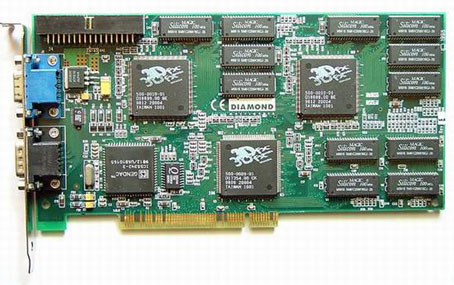
Image of a 3Dfx Voodoo2 Creative observed in the SLI connector.
The project was abandoned with the standardization of AGP graphics port , of \u200b\u200bwhich only one can be mounted on the motherboard, but that eventually allowed increases of power in the unthinkable graphics cards plugged into an PCI slot.
In NVidia 2004 relaunched this project, this time taking advantage of the benefits offered by new graphics cards and all port PCIe 16x.
This system works only on motherboards with dual 16x PCIe graphics, specifically developed to support this technology (not all motherboards that have 2 x PCIe x16 support SLI).
The two boards are connected by a small circuit board connector to a connector with these cards. This connector provides a link to transmit data synchronization, display, and pixel between the two GPUs. Providing communication between the two graphics processors speeds of up to 1 GB / s. without consuming bandwidth of the PCIe bus.
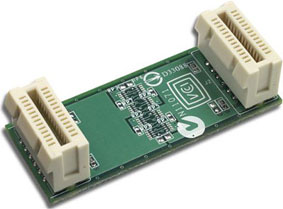
Connect to SLI.
software distributes the workload of two ways.
- SFR or Split Frame Rendering, which analyzes the image to display in a table and divide the load equally between the two GPUs.
- or AFR Alternate Frame Rendering , in which each frame is processed by a GPU, alternately, that is, a picture is processed by the first GPU and the next by the second.
Initially the two graphics cards had to be exactly alike, of the same make, model and capacity .
This has changed over time, and can be currently applied to the system two different graphics cards manufacturer, provided and they have the same GPU (NOTE: In the words of a different manufacturer we do not mean to put a NVidia card and a ATI, which in this case, the GPU is different, and the technology used ( in CrossFire For ATI). Not even able to put a GForce 7300 with a GForce 7600, in which case the GPU are different, we mean to put a graphic Asus and Sapphire, for instance, if both SLI compatible and have the same GPU).
can even mix two different cards with memory capacity, although in this case the result will not be the sum of both, but the result of multiplying the lowest x 2, wasted the rest of memory.
This allows (in the case of two identical graphics cards) to increase performance by between 75% and 100% (not all applications will have the same increase in performance).
Keep in mind that this increase in yield only what we get in those applications designed to use the full power of the GPU (as is the case with the latest games, programs, CAD / CAM and Most current graphics applications).
Another application is viewing SLI on multiple monitors.
If configured in multi GPU mode, only one monitor, but a single GPU mode is possible to employ a total of 4 monitors (two per card) simultaneously, using technology NVidia nView and function of Windows Dualview.
The list of cards that support SLI NVidia today (provided by NVIDIA on their web) is as follows:
NVIDIA GeForce 8800 GTX NVIDIA GeForce 8800 GTS NVIDIA GeForce 8600 GTS
NVIDIA GeForce 8600 GT NVIDIA
NVIDIA GeForce 7950 GX2 GeForce 7950 GT NVIDIA GeForce 7900 GTX
NVIDIA GeForce 7900 GT NVIDIA GeForce 7900 GS
NVIDIA GeForce 7800 GTX 512 NVIDIA GeForce 7800 GTX
NVIDIA GeForce 7800 GT NVIDIA GeForce 7600 GT NVIDIA GeForce
7600 GS NVIDIA GeForce 7300 GT * NVIDIA GeForce 7300
GS * NVIDIA GeForce 7300 LE * NVIDIA GeForce 7100
GS * NVIDIA GeForce 6800 Ultra NVIDIA GeForce 6800 GS
NVIDIA GeForce 6800 GT NVIDIA GeForce 6800 NVIDIA GeForce 6800 XT
NVIDIA GeForce 6800 LE NVIDIA GeForce 6600 GT
NVIDIA GeForce 6600 * NVIDIA GeForce 6600 LE * NVIDIA SLI-Ready
Quadro GPUs
* Only GT versions or higher in 6600 and 7300 models.
In lower versions of cards that support SLI communication is done through the 16x PCIe bus, but being lower performance cards that bus has sufficient bandwidth to it does not lead no problem.
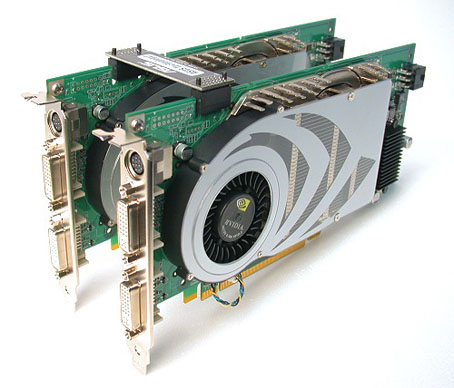
Two connected Gforce 7800 GTX in SLI.
 What is CROSSFIRE?
What is CROSSFIRE? CrossFire is the name ATI / AMD gave his dual GPU system, designed in response to the system of NVidia SLI .
Although the purpose of both is the same and have many things in common, the system to achieve this varies from one system to another. Especially
have in common that only work on PCIe graphics , in the case of CrossFire motherboards and graphics cards, CrossFire certified .
this technology in principle allows only thing is that both cards share the workload of rendering images.
All other tasks related to graphics processing are carried out only by a GPU.
For distribution of this process of rendering ATI / AMD uses three different systems:
- or AFR Alternate Frame Rendering , which is the method that gives a greater increase in performance, and that is that each graphics card render alternate frames (equal to one of the systems used by SLI the same name).
-Scicorring that what is done is to divide each frame into two parts. These parts need not be the same as the length of each card renders the image is dynamically allocated.
- STB or Super Tile Board, which divides the image into small pieces of 32x32 pixels, creating a sort of mesh or board. In this case each card renders small alternating squares of split image, superimposing images generated after each card, creating the image that is displayed on screen.
As for connecting system boards also no difference between the two systems. The system
CrossFire used three different systems to make this connection:
- The cards used for low range is to use the PCIe bus itself to transmit visual data between GPUs. This system was scrapped for higher-end cards, due to excessive consumption of bandwidth of PCIe for large resolutions, which means a decrease in overall system performance, as with the example of the image.
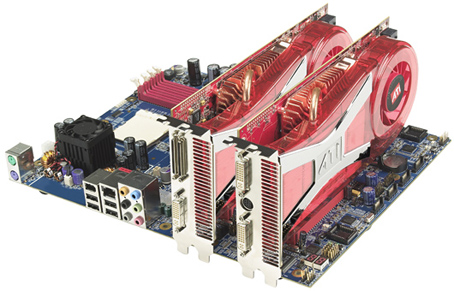
Charts CrossFire connected via PCIe bus. In this case it is two Radeon X1950 CrossFire Edition
- The most common way to mount the rest CrossFire ATI card is using a CrossFire Master Card and other CrossFire Slave. The first replaces a DVI connections for a special connection through an external cable that allows us to link two graphics cards together and simultaneously with the monitor.
One of the biggest problems of this system is that having to find a graph CrossFire Master, which are very rare. This means that to build a system crossFire not only have to put two cards are exactly alike, but also one has to be a Master version.
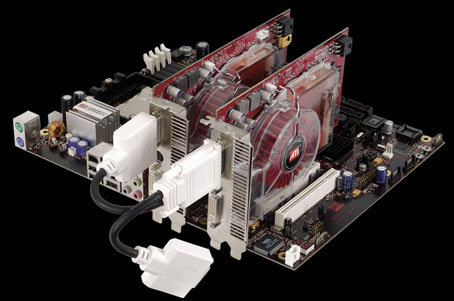
image external cable CrossFire connection.
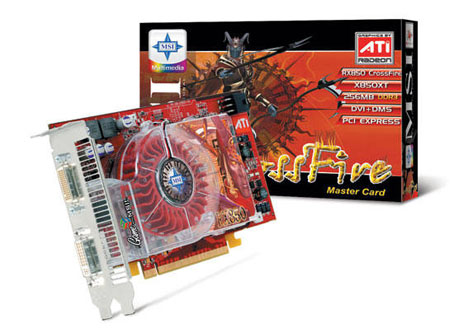
In the picture, a Radeon X850 CrossFire Master.
- The third system, while the newer, is much like the bridge used in the SLI system, but in this case with two printed circuit connectors instead of one, as is the case with NVidia .
So far this method is only being used in series cards PRO. This provides a transfer rate almost double the one achieved by the SLI bridge system (up 2Mbs). Furthermore, this system is to avoid external cable assembly simplifies the CrossFire system by not having to find versions CrossFire Master Card you want to install.
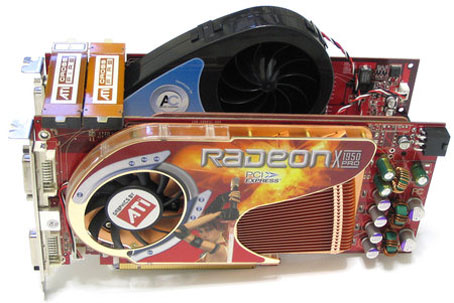
Radeon X1950 PRO Two connected in CrossFire. We can see the double bridge.
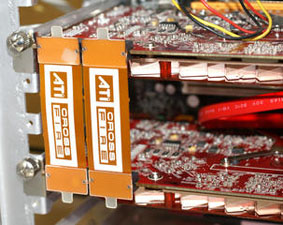
Details CrossFire dual jumper.
The list of supporting ATI CrossFire to date (provided by ATI on its website) is as follows:
RADEON HD 2900XT PCIe RADEON X1950 Crossfire Edition
RADEON X1950 RADEON X1950 XTX
RADEON X1900 PRO
XTX RADEON X1900 XT RADEON X1900 GT
RADEON X1900 CrossFire Edition Radeon X1800 XT
RADEON X1800 XT RADEON X1800 XL
RADEON X1800 GTO 256MB
RADEON X1800 CrossFire Edition RADEON EAX1650 PRO
RADEON X1650 RADEON X1650 PRO
RADEON X1600 XT RADEON X1600 PRO
RADEON X1300 XT RADEON X1300 XT
PRO RADEON X850 XT RADEON X850 PRO
It is interesting to ride one of these systems?.
Of course it's interesting to ride one of these systems ... provided that we will make use of them, not just occasionally.
Keep in mind that riding a SLI or CrossFire to get good performance out quite expensive as the premium of the base plate (approximately 75% more expensive than its counterpart without such systems) is that add the cost of the two graphics cards (high end), a fairly powerful processor and enough RAM.
If we will not go to these lengths may be more cost effective to install a high-end graphics card to use a system SLI or CrossFire .
I hope they can note a greeting Patagonian.


0 comments:
Post a Comment